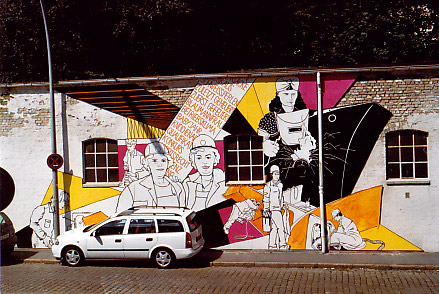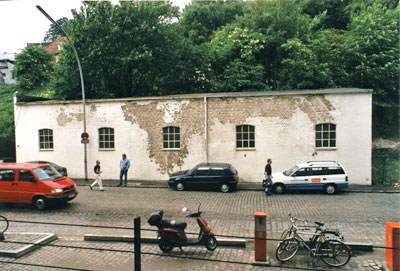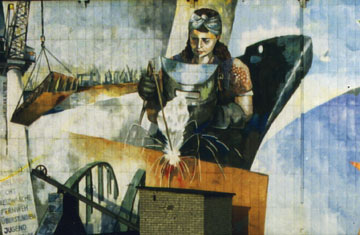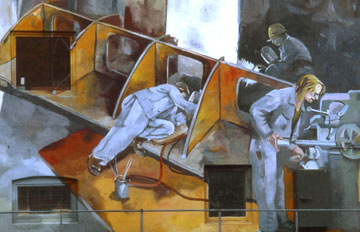Women metal workers and welders in the harbour, 2000

"Women metal workers and welders in the harbour"
Große Elbstraße 264 / 266
Design and realisation: Hildegund Schuster.
Sponsors: R&S Baugesellschaft - Photo: Hildegund Schuster ©
In September 2000, the painted panels of the mural were removed because
the building was being demolished. The painted panels were purloined in 2002.
Our ninth mural on the former engine shed of the port railway was only granted a brief stay. Following months of negotiations with Fischmarkt Hamburg-Altona GmbH, finally in 1998 we were able to sign a complicated contract that gave us the usage rights to a precisely defined surface of this building. Furthermore, panels were to be used as the substrate to protect the building itself, causing us additional costs.
However, it was not possible to start work on the mural in spring 1999 as planned because our agreed surface was blocked by a bridge-like scaffolding structure carrying electric cables for the construction site on the other side of the road so that we were not able to erect our own scaffolding.

Engine shed of the former port railway in 1999
Große Elbstraße 266
- Photo: Hildegund Schuster ©
Finally, work began at last in May 2000. Firstly the aluminium panels were cut to size, then mounted and finally painted. The mural was dominated by its irregular shape reaching out dynamically in all directions. A reduced comic-like colour scheme was used for the various figures in the collage design.
While painting was in progress, Fischmarkt Hamburg-Altona GmbH informed us that the demolition permit had now been received for this building and that we would have to remove the mural at our own costs by the end of September. Assisted by many women, we took the panels down again, numbered them on the back and looked for somewhere to keep them in storage. It was possible to leave the panels standing undisturbed on the yard of the company Schaumstoff Lübcke, but after about two years, they suddenly disappeared. A stolen mural.
The painting is dedicated to the female welders, lathe operators and machine fitters who gained a foothold in these typical men's jobs.
Linking up with the big mural of 1989, our main intention was to reproduce the large image of the female welder who many passers-by will remember having seen from a far distance.
After the war, there was a shortage of men in the port so that when they were allowed to build ships again in the 1950s, shipyards such as Blohm und Voss recruited women to join their workforce and learn welding in just a few weeks.
They set to work, sometimes working in women's gangs and always on a piecework basis, welding ship's segments, often enough lying in awkward positions, in the cold, noise and dirt - but even so, they still did not get paid the same wages as their male colleagues, despite doing the same job.
Many women stayed with the shipyards for many years and were proud of their achievements when "their" ships were launched.
The lathe operator at Blohm & Voss has also found her calling and turns various workpieces into pistons, shafts, threads etc.
The Pohl & Jozwiak shipyard was the only one to train women as machine fitters until it went bankrupt at the end of the '80s. Here the women got involved in youth representation and in the works council.
© Hildegund Schuster, 2021

The welder from the 1950s:
excerpt from the old mural of 1989
Photo: Hildegund Schuster ©

Welders and lathe operators:
excerpt from the old mural of 1989
Photo: Hildegund Schuster ©

